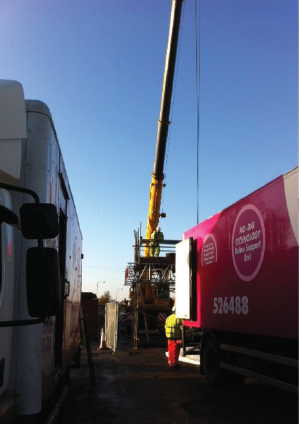Tramline sewer rehabilitation
 Civil engineering and transport technology consortium Taylor Woodrow Alstom was commissioned to build a Phase 2 extension of the Nottingham Express Transit (NET) tramline. The 17 kilometre route is designed to transform public transport infrastructure in the city.
Civil engineering and transport technology consortium Taylor Woodrow Alstom was commissioned to build a Phase 2 extension of the Nottingham Express Transit (NET) tramline. The 17 kilometre route is designed to transform public transport infrastructure in the city.
NET 2, due to open at the end of 2014, more than doubles the size of Nottingham’s tram network, providing a service to an estimated 23 million passengers a year.
It creates 28 new tram stops and provides a quick, efficient and green commuter service for 20 of the 30 largest employers in the greater Nottingham area, including the main campus of the University of Nottingham.
As part of this major transport infrastructure programme, Lanes Group was commissioned to survey the drainage system along the route and use its trenchless technology to rehabilitate sewer pipes.
The project
The new Nottingham Express Transit (NET) Phase 2 tram extension runs from the city’s western suburbs of Chilwell and Clifton into the city centre.
The route is designed to serve some of the city’s biggest employers and institutions, including the University of Nottingham.
As such, it is expected to have a major impact on the number of commuters and travellers who will switch from making car journeys through the city to public transport, reducing traffic congestion, contributing to improvements in environmental standards and enhancing quality of life.
As with all major transport projects, a key part of the programme is to ensure utility services along the route have sufficient capacity and are in good condition so they will not require upgrade for a significant period of time after new assets are in place.
On board with trenchless technology
For NET 2, Lanes Group was commissioned to carry out all CCTV drainage survey work along the route. Remote-controlled robot cameras were used to generate HD quality video footage of the inside of the pipes to allow Severn Trent, the sewer network’s owner, and the NET 2 civil engineers to determine the repair and rehabilitation work required.
For a project of the size of NET 2, this is a major undertaking. Lanes surveyed about 400 metres of pipe – for both foul sewer and surface water drains – every day.
Pipes range from 100mm to 750mm in diameter, plus some underground culverts big enough to drive a car along.
As this survey evidence was analysed, a rolling programme of rehabilitation work was put together. Lanes’ Reline Division was commissioned to reline a number of sections of pipe ranging in diameter from 225mm to 600mm.
Quicker, more cost-effective and less disruption
The Lanes teams used a technique called cure in place pipe (CIPP) relining. A flexible fibre glass liner, impregnated with resin, is forced into the sewer under pressure from water.
Once in place, the liner is left to cure (harden), creating a tough, smooth and waterproof new pipe wall inside the sewer, giving the sewer up to 30 more years’ of life.
The technology allows long runs of sewer pipe to be renewed without the need for costly, time-consuming and expensive excavation work.
This was particularly important given the tight timescales for the delivery of this major transport project – and the fact that much of the tramline runs through suburban housing estates, where it was essential to keep disruption to an absolute minimum.
Client Benefits
•Successfully co-ordinating the CCTV drainage survey of thousands of metres of pipelines associated with a major transport civil engineering project
• Managing sewer rehabilitation activity in residential areas in a way that ensures disruption and complaints are kept to an absolute minimum
•Meeting demanding deadlines within ‘windows of opportunity’ to carry out sewer improvement tasks
•Coordinating complex sewer rehabilitation work with other contractors
Further reading
-

Tramline sewer rehabilitation PDF
Download PDF







